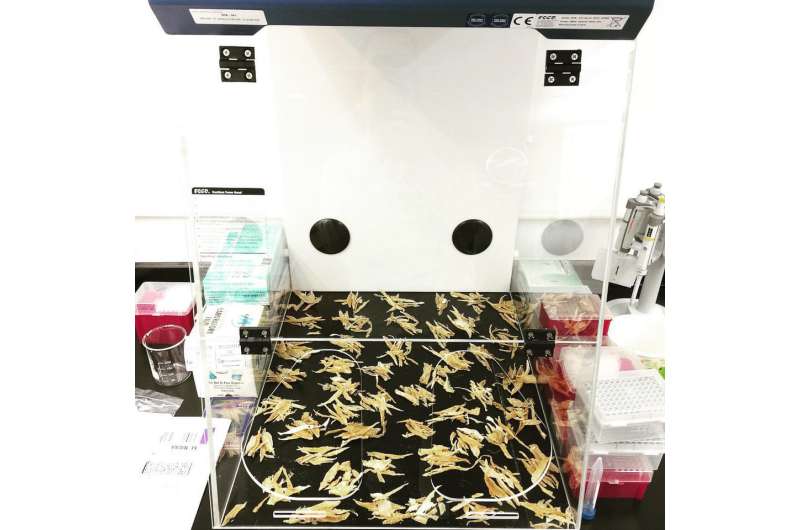Study shows fin trade still trafficking in threatened sharks

Genetic analysis of 9,200 shark fin by-products in Hong Kong reveals that several threatened shark species are still common in the fin trade after being listed on the Convention on International Trade in Endangered Species of Wild Fauna and Flora (CITES). Hong Kong is one of the world's largest importers of shark fins, which are used to make the delicacy shark fin soup. The study, published in Conservation Letters , is the first assessment of the species composition of the fin trade after CITES regulations were put in place for commercially important shark species. The paper's lead author is Diego Cardeñosa, a Ph.D. student in the School of Marine and Atmospheric Sciences (SoMAS) at Stony Brook University.
Since September 2014, CITES has regulated scalloped hammerheads, smooth hammerheads, great hammerheads, oceanic whitetips, and porbeagle sharks, some of the world's most vulnerable and highly traded shark species. This means that permits are required to ship their products from country to country. From February 2014 to December 2016, a collaborative research team from the U.S. and Hong Kong surveyed small scraps that are produced when imported fins are processed – when the skin, meat and cartilage is trimmed off the fin. They conducted DNA testing on randomly selected scraps to look for CITES-listed species. They also recorded the incoming weights of fins from these species reported through the CITES Trade Data Base in 2015. According to this database there were only 16 shipments of these species into Hong Kong at a total weight that was less than one half of a percent of the weight of all fins imported that year.
"If this is an accurate reflection of imports, we would expect CITES-listed species would be uncommon among fins being processed in 2015-2016," says Cardeñosa.
"However, our research shows is that these species are still commonly being processed at least one year after regulations were implemented," emphasizes Cardeñosa. "In fact, CITES-listed scalloped and smooth hammerheads represented the 4th and 5th most common species found in our survey, out of 82 species and species groups in total." He also pointed out that because the time lag between import and processing is unknown, it is difficult to determine if some of the fins were imported before the regulations were in place.
"Although we can't rule out some delayed processing of fins, the disconnect between reported imports and how common these species were in our survey does suggest that major underreporting of CITES imports is occurring," says Cardenosa. "It also seems unrealistic that many countries that exported fins of these species to Hong Kong suddenly stopped doing so when the regulations came in. But these findings would be consistent with other studies that have shown that compliance with CITES regulations is relatively low during the initial phase of implementation."
"It is great that there is now a system in place to monitor trade in these threatened shark species," said Dr. Demian Chapman, the leader of the research team, from Florida International University. "But listing them is just the first step. Our study highlights that countries fishing, trading, and consuming shark products all have a lot of implementation work to do."
The team made some practical suggestions on how to improve inspection efficiency so that shark-importing nations like Hong Kong can better meet their obligations to CITES. While Hong Kong has been successful in their implementation efforts – hosting nine CITES workshops for enforcement officials which led to the seizure of 5.1 metric tons of fins from listed species since late 2014 – the research team recommends these additional actions:
- Scaling up inspection capacity by employing additional inspectors
- Improving inspection efficiency by centralizing ports of entry for fins and conducting real-time DNA testing in the field
- Conducting assessments to flag high-risk shipments to prioritize inspections
Cardeñosa is now living and studying in Hong Kong to help the authorities develop new approaches to monitoring fin imports for CITES listed species, including DNA testing of fins directly at the port of entry.
"There is tremendous public support for better management of the shark fin trade in Hong Kong and the government has been willing to work with us and others to control what is coming in more effectively," said Cardeñosa. "I am hopeful that with cooperation, increased investment, and time, CITES regulations will be fully implemented for these threatened sharks."
More information: Diego Cardeñosa et al. CITES-listed sharks remain among the top species in the contemporary fin trade, Conservation Letters (2018). DOI: 10.1111/conl.12457
Journal information: Conservation Letters
Provided by Stony Brook University



















